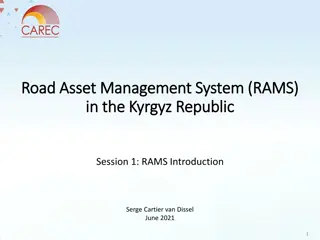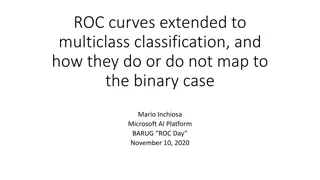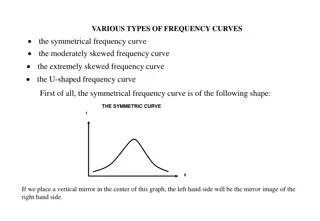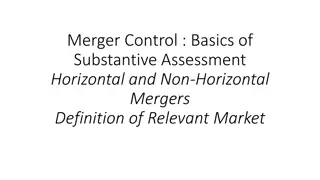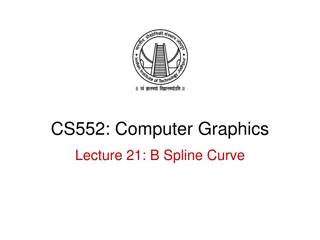Horizontal Curves in Road Design
Horizontal curves are essential in road design to safely change alignment or slope. This article covers types of horizontal curves, setting out methods, geometric shapes of curves, and elements such as PI point, PC point, and radius. Learn why curves are crucial for modern highways and how different types like simple, compound, and reverse curves are utilized.
Download Presentation

Please find below an Image/Link to download the presentation.
The content on the website is provided AS IS for your information and personal use only. It may not be sold, licensed, or shared on other websites without obtaining consent from the author.If you encounter any issues during the download, it is possible that the publisher has removed the file from their server.
You are allowed to download the files provided on this website for personal or commercial use, subject to the condition that they are used lawfully. All files are the property of their respective owners.
The content on the website is provided AS IS for your information and personal use only. It may not be sold, licensed, or shared on other websites without obtaining consent from the author.
E N D
Presentation Transcript
Horizontal Curves Horizontal Curves - Introduction: - Types of H Curves - Elements of H Curve - Data for Setting Out - Setting Out Methods: 1- Offset from tangent 2- Offset from main chord 3- Deflection angle method
Introduction Introduction What are Curves and Why are they used? What are road curves? The center line of a road consists of series of straight lines interconnected by curves that are used to change the alignment, direction, or slope of the road. Those curves that change the alignment or direction are known as horizontal curves, and those that change the slope are vertical curves. Why are they used? When a highway changes horizontal direction, making the point where it changes direction a point of intersection between two straight lines is not feasible. The change in direction would be too abrupt for the safety of modem, high-speed vehicles. It is therefore necessary to interpose a curve between the straight lines. The straight lines of a road are called tangents because the lines are tangent to the curves used to change direction.
Geometric Shape of Horizontal Curve Geometric Shape of Horizontal Curve Geometric Shape: In practically all modem highways, the curves are circular curves. The smaller the radius of a circular curve, the sharper the curve. For modern, high-speed highways, the curves must be flat, rather than sharp. That means they must be large-radius curves. Some typical radii you may encounter are 5,000 m or longer on a main highway, 300m on a major through-fare in a city, 200 m on an industrial access road, and 50 m on a minor residential street. See Fig. 1, next slide:
Horizontal Curves Horizontal Curves Circular Horizontal Curve
Types of H Curves Types of H Curves 1- simple, 2- compound, 3- reverse, 4-transitional: (figure 2) Fig. 2.
Types of Horizontal Curves Types of Horizontal Curves Simple Circular Compound
Elements of Horizontal Curve Elements of Horizontal Curve Main elements (Figure 3): Fig. 3 PI POINT OF INTERSECTION. PC POINT OF CURVATURE or initial Point of curvature. PT POINT OF TANGENCY, or Ending Point of curve. O Center point of curve. R Radius of Curve. PC-PI Tangent of curve, perpendicular To the radius at PC or at PT (Distance T)
Elements of H Curve Elements of H Curve Continued I INTERSECTING ANGLE. The intersecting angle is the deflection angle at the PI. Its value is either computed from the preliminary traverse angles or measured in the field. CENTRAL ANGLE. The central angle is the angle formed by two radii drawn from the center of the circle (O) to the PC and PT. The value of the central angle is equal to the I angle. Some authorities call both the intersecting angle and central angle either I or . POC POINT OF CURVE. The point of curve is any point along the curve. L LENGTH OF CURVE. The length of curve is the distance from the PC to the PT, measured along the curve. LC LONG CHORD. The long chord is the straight-line distance from the PC to the PT. Other types of chords are designated as follows:
Elements of H Curves Elements of H Curves Continued C one-tenth stations) along a curve. C1 The sub-chord distance between the PC and the first station on the curve. C2 The sub-chord distance between the last station on the curve and the PT. E EXTERNAL DISTANCE. The external distance (also called the external secant) is the distance from the PI to the midpoint of the curve. The external distance bisects the interior angle at the PI. M MIDDLE ORDINATE. The middle ordinate is the distance from the midpoint of the curve to the midpoint of the long chord. The extension of the middle ordinate bisects the central angle. D DEGREE OF CURVE. The degree of curve defines the sharpness or flatness of the curve The full-chord distance between adjacent stations (full, half, quarter, or
Radius of Horizontal Circular Curve Radius of Horizontal Circular Curve Curve radius (R) is either given directly by the highway engineer or can be determined from designated curvature of the curve. Degree of Curve (Arc Definition) The arc definition is most frequently used in high-way design. This definition, illustrated in figure 4, states that the degree of curve is the central angle formed by two radii that extend from the center of a circle to the ends of an arc measuring 100 meters long. Therefore, if you take a sharp curve, mark off a portion so that the distance along the arc is exactly 100m, if the corresponding central angle is 12 , then you have a curve for which the degree of curvature is 12 ; it is referred to as a 12 curve. By studying figure 4, you can see that the ratio between the degree of curvature (D) and 360 is the same as the ratio between 100 m of arc and the circumference (C) of a circle having the same radius.
Degree of Curve Degree of Curve Arc Definition Arc Definition Fig. 4 Arc Definition The ratio between the degree of curvature (D ) and 360 is the same as the ratio between 100m of arc and the circumference (C) of a circle having the same radius. (D /360 ) = (100/C) where C= 2 R, R = (360x100)/(2 D) R = 5729.58/D meters
Degree of Curve Degree of Curve - - Chord Definition Chord Definition The chord definition (fig. 5) is used in railway Fig. 5 practice and in some highway work. This definition states that the degree of curve is the central angle formed by two radii drawn from the center of the circle to the ends of a chord 100 m long. If you take a flat curve, mark a 100-m chord, and determine the central angle to be 0 30 , then you have a 30-minute curve (chord definition). or
Solved Example Given a circular curve with degree of curvature 20 , compute the radius of the curve using: a) Arc definition, b) Chord definition a) Arc definition: R = 5729.58/D m = 286.48m b) - Chord definition: R = 50/(sin 10 ) = 287.94m
Curve Geometric Formulae Curve Geometric Formulae Referring to Fig. 3: Tangent Length, (T); tan ( /2) = T/R; Hence T = R tan ( /2) Chord Length (C),; C = 2 R sin ( /2), fig 6. Length of Curve (L) , fig 7 Fig. 6 In figure 7, the relationship between D, , and L, and a 100- meters arc length may be expressed as follows: (L/ = 100/D) , or L = (100 x /D) Since, D = 5729.58 / R, then Fig. 7 L = 100 x x R / 5729.58 = R * ( in radians) = R * o* / 180
Curve Geometric Formulae Curve Geometric Formulae Referring to Fig. 3: Middle Ordinate (M) and External Distance (E): M MIDDLE ORDINATE. The middle ordinate is the distance from the midpoint of the curve to the midpoint of the long chord. The extension of the middle ordinate bisects the central angle. E EXTERNAL DISTANCE. The external distance (also called the external secant) is the distance from the PI to the midpoint of the curve. The external distance bisects the interior angle at the PI.
Setting Out Curve Setting Out Curve For setting out a simple circular curve follow the following steps: 1ststep: Locate Intersection point and measure intersection angle. 2ndstep: Compute tangent length and set out initial point of curvature PC, If there is obstruction to intersection point positioning as in figure 8 below: select two points on the two straights; A and B. Measure length of AB and angles at A and B. Solve triangle ABPI for A-PI and B-PI (Tangent length) and angle A-PI-B, for intersection angle I. Using angle I and given curve radius compute tangent length, T. From A set out PC by going back a distance A-PC = T - A-PI (see figure 8 on next slide) Then: Prepare data for one of the following setting out methods:
Hindrance to PI Location Hindrance to PI Location To find Tangent length T if PI cannot be occupied for some reason: Fig. 8
Setting Out by Offset from Tangent Offset from Tangent The position of the curve is located by right-angled offsets Y set out from tangents along distances X (Fig 9), thereby fixing half the curve from each side. The offsets may be calculated as follows for a given distance X. Consider offset Y3, for example. Fig. 9 In ABO, AO2= OB2-AB2, (R-Y3)2 = R2 X 32and R - Y3= (R2-X 32) Thus for any offset Yi, at distance Xi, along the tangent: Yi = R - (R2- Xi2)
Offset from Tangent Offset from Tangent Or, R2+ Y32- 2RY3 = R2 X32 Dividing both sides by 2R: Y32/2R - Y3= - X32/ 2R, since Y32is very small compared to 2R, it can be neglected and the formula reduces to: Y3= X32/ 2R And in general: Yi= Xi2/ 2R This equation is only accurate for large radii curves Example Derive the data needed to set out a circular curve of radius 50m using offsets, every 5m, from the tangent, assuming both tangent points and intersection point were fixed on ground. Using the relation Yi = Xi2 / 2R, the following data are computed and tabulated: Xi (m) 5 10 20 40 Yi (m) ? ? ? ? Check this solution using the relation: Yi = R - (R2 - Xi2)
Offset from Offset from Main Chord Main Chord Main chord joins starting and ending points of curvature PC and PT, In this case the right-angled offsets X are set off from the long chord PC-PT, at distances Y along the chord Measured from mid- point F, left and right to each side of the center point F Offset Xmat mid-point F is given as Xm= FC = OC OF = [R (R2- (L/2)2)1/2]
Offset from Offset from Main Chord Main Chord Referring to fig. 10 on previous slide: From triangle PC O F, R2= (R Xm)2+ (L/2)2, (R Xm)2= R2- (L/2)2 From triangle ODE, (R Xm+ X)2+ Y2= R2, this can be written as: R Xm+ Xi= (R2 Yi2)1/2; Xi= (R2- Yi2)1/2 (R - Xm) Xi= (R2- Yi2)1/2 [R2- (L/2)2]1/2
Setting out Setting out using using deflection angle deflection angle In the previous two methods only linear measurement and right angle were used. Deflection angle method would need distance (chord length) and horizontal angle from tangent to be set out. This is illustrated in figure 11. Fig 11. First deflection angle, d (in radians) = arc PC-A / (2R). Assuming arc PC-A = Chord PC-A when chord length R/20 m, then d (in radians) = chord PC-A / (2R). d (in minutes) = chord PC-A * (180 * 60 / ) / (2R) = chord PC-A * 1718.9 / R
Example Example Solved example: The centerlines of two straights are projected forward to meet at I, the intersection (deflection) angle I is measured as 30o00' 00". If these two straights are to be connected by a circular curve of radius 200m. Tabulate all setting out data, assuming 20m chords. Let chainage of I (ChI) be 2259.59m. Solution: given data: ( = I = 30o, R = 200m, ChI = 2259.59m) Tangent length (T) is calculated from: T=R tan( /2) = 200 tan (30/2)o= 53.59m. Chainage of PC = Chainage of I - T = 2259.59 - 53.59 = 2206.00m Let first sub-chord = c1= 14m (so that chainage of first curve point A will be a whole chainage = 14 + 2206.0 = 2220.0m) Length of circular curve, L = R * o* / 180 = 200 * 30 * / 18 = 104.72m
Solution continued Solution continued From this: If first sub-chord length is 14m, there remains 104.72- 14.00 = 90.72m, of which 80m will be the summation of four chords each 20m length. The second sub-chord c2= 90.72 80.00 = 10.72m To calculate deflection angle for each chord we use the relation: deflection angle (in minutes) = 1718.9*Chord length/R. For first sub-chord (14m), d = 1718.9*14/200 = 120.3' = 2o00' 19" For standard chords (20m), d = 1718.9*20/200 = 171.9' =2o51' 53" For second sub-chord (10.72m), d=1718.9*10.72/200 = 92.1' = 1o32' 08"
Table of Required Data Table of Required Data Results will be tabulated as follows: Chord Chord length (m) Chainage (m) of curve point Deflection angle O Setting out angle O Remarks 1 14 2220.00 2 00 19 2 00 19 Peg 1 on curve 2 20 2240.00 2 51 53 4 52 12 3 20 2260.00 2 51 53 7 44 05 4 20 2280.00 2 51 53 10 35 58 5 20 2300.00 2 51 53 13 27 51 6 10.72 2310.72 1 32 08 14 59 59 Last peg on PT Check sum of deflection angles that should be equal to /2 = (30/2) = 15o









